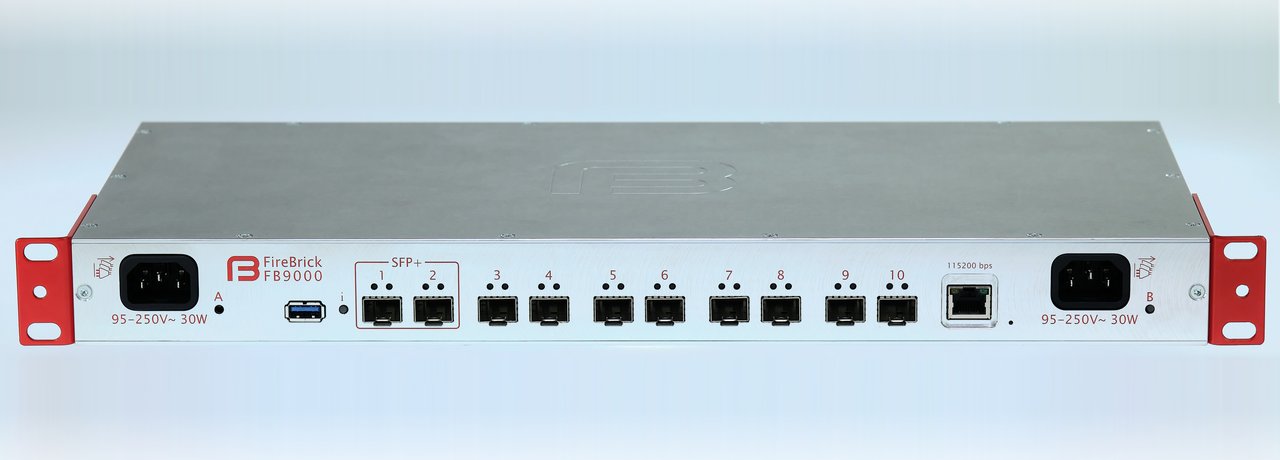The FB9000 is designed primarily for termination of multi-gigabit wholesale broadband links allowing termination of broadband and mobile L2TP sessions from networks such as BT Wholesale, TalkTalk Business, Vodafone, Zen Wholesale, CityFibre and others. It is designed to handle multiple gigabits of normal Internet traffic levels and handle sufficient tunnels and sessions for that level of usage.
Authentication and accounting is by means of RADIUS. Allocated IPv4 and IPv6 addresses being announced by BGP sessions.

One of the stand-out features of the FireBrick running as an LNS is it's ability to send LCP echoes every second to every circuit and create loss/latency/throughput graphs and xml data files.
This happens all the time, no need to enable it when a customer calls up saying they have problems.
You can archive and store historical graphs so that they can be integrated with your own staff or customer management portals.
Technical support staff will find the graphs invaluable when investigating faults with customer's circuits when faced with questions regarding speeds or congestion.
Loss, latency and throughput all tell a story about the quality of the connection, a poorly running service is instantly easy to spot.
Staff can compare graphs across your estate to find problems with particular back-haul services, and find patterns when investigating similar-sounding fault reports.
FireBrick LNSs in an ISP:

Full features for one price, no per session licencing or other extra costs.
Five year warranty on hardware against any manufacturing defect. Normal working hours / courier replacement. Recommended that two units are used together to provide hardware redundancy. On-going maintenance contracts available for extended hardware support beyond one year.
1U, dual AC 120/240V inlets (monitored), 2 internal fans (monitored), approx 30W total power consumption.
Multi-position 19" rack mount ears, with variation for hanging mount in shallow depth telco racks.
Free of charge, beta and released software. Internal flash holds up to 8 prior versions with automatic fallback on crash/watchdog.
Reboot or software upgrade with clean shutdown of L2TP, BGP, VRRP, etc, for minimal disruption. Boot time under 1 second.
UK based s/w support team - email and irc support during office hours.
Configuration defined by an XML document according to a published XSD schema. The configuration may be uploaded and downloaded by HTTP (e.g. using curl). In addition the web interface contains an interactive configuration editor.
Configuration changes are applied as seamlessly as possible when loaded without the need to re-boot.
The command line provides a number of commands to provide viewing of BGP, and pinging status data, as well as clearing BGP sessions. Includes tab completion and interactive help text.
Two SFP+ 10-Gigabit ports and eight SFP 1-gigabit ports allowing 4096 VLANs on each. 100 independent routing tables which can be used with BGP. Each port/VLAN can be attached to a specific routing table.
Access lists of telnet, web, SNMP. These can also be attached to an independent routing table for specific port/VLANs.
SNMP (read only) support for a number of functions including interface stats for each port/VLAN in use and individual ping state (up/down).
Simple NTP client to set clock for accurate logging with fallback via list of configured servers.
DHCP client mode available, multiple instances. Also RA client for IPv6 addressing.
RA server for passive IPv6 adress allocation to LAN.
IPv4 VRRP2 and IPv4/6 VRRP3 server.
L2TP incoming connections and outgoing L2TP relay. RADIUS is used for authentication and accounting.
CQM provides graphs for last day, and for nightly archive, for L2TP sessions based on circuit ID from RADIUS, and for external interfaces.
RADIUS authentication and accounting allows configuration of session settings and logging of usage. Configurable fallback and blacklisting of non responsible servers.
RFC5176 Disconnect message and change of authorisation are supported allowing on the fly changes of routing table, closed user group, routes, and line speed without dropping session. Ideal for handling BRAS rate changes seamlessly.
A RADIUS server provides responses to platform RADIUS requests directing sessions to the FB9000 or alternative endpoints based on simple pattern match. Tested against BT, Be, Zen and 3UK hand-overs.
BGP is provided to allow interface to carrier (e.g. BT) to accept routes to BRASs, etc, and announcing routes to ISP core network.
IPv4 and IPv6 BGP sessions.
Syslog to external server with various levels of debugging data available. Logs also available live via command line interface.